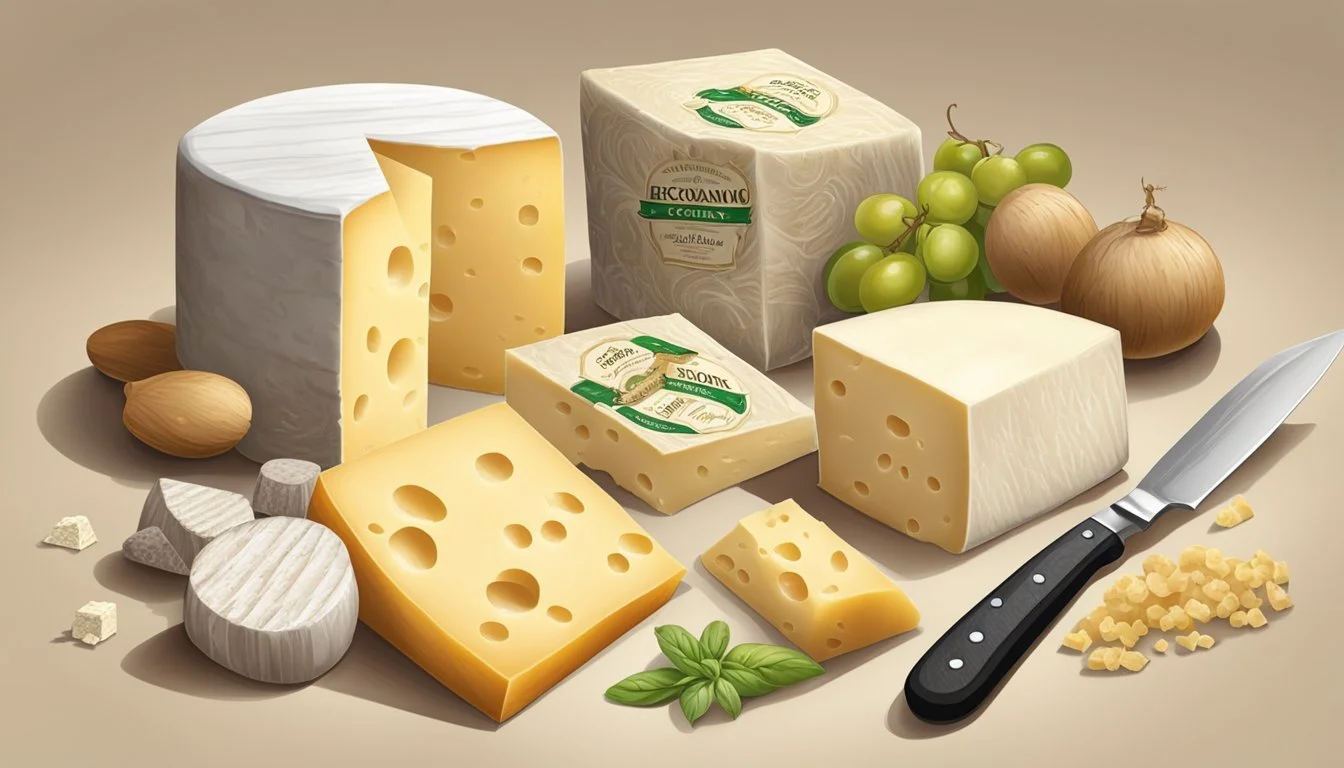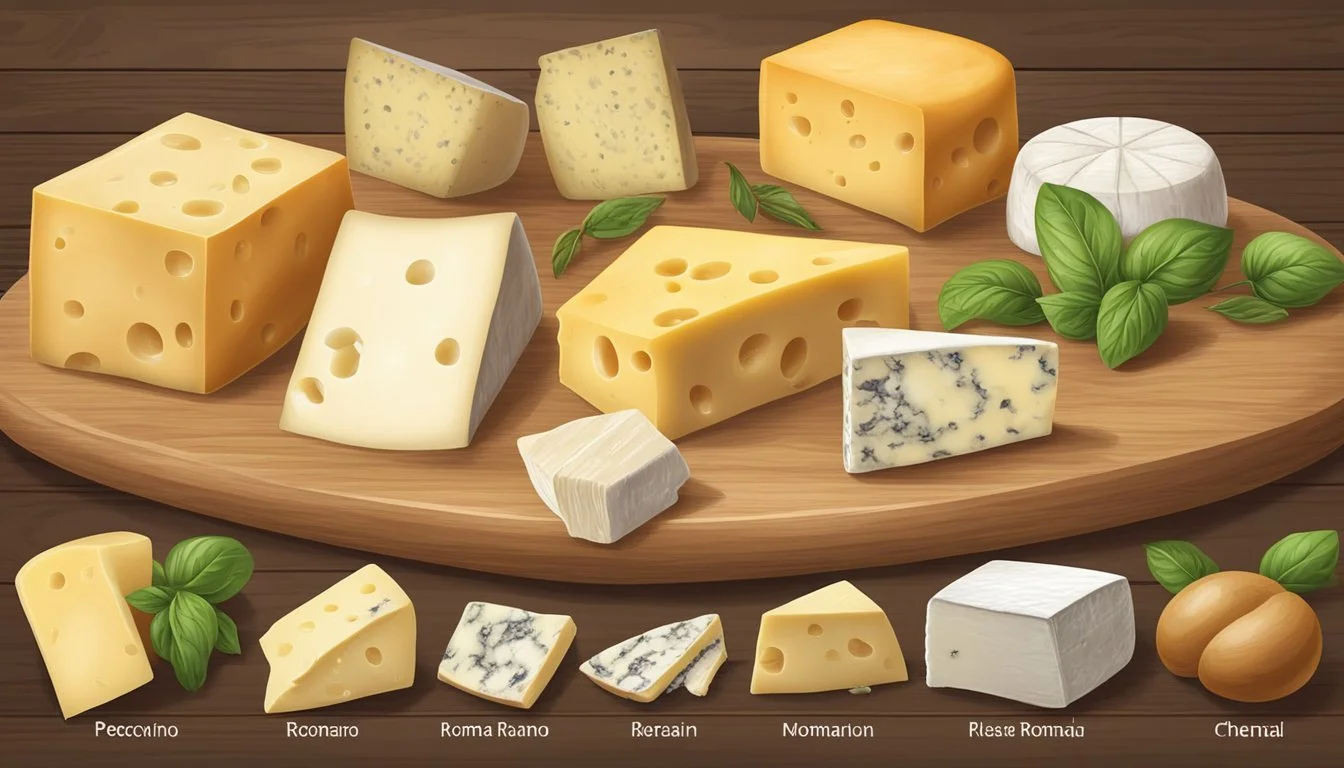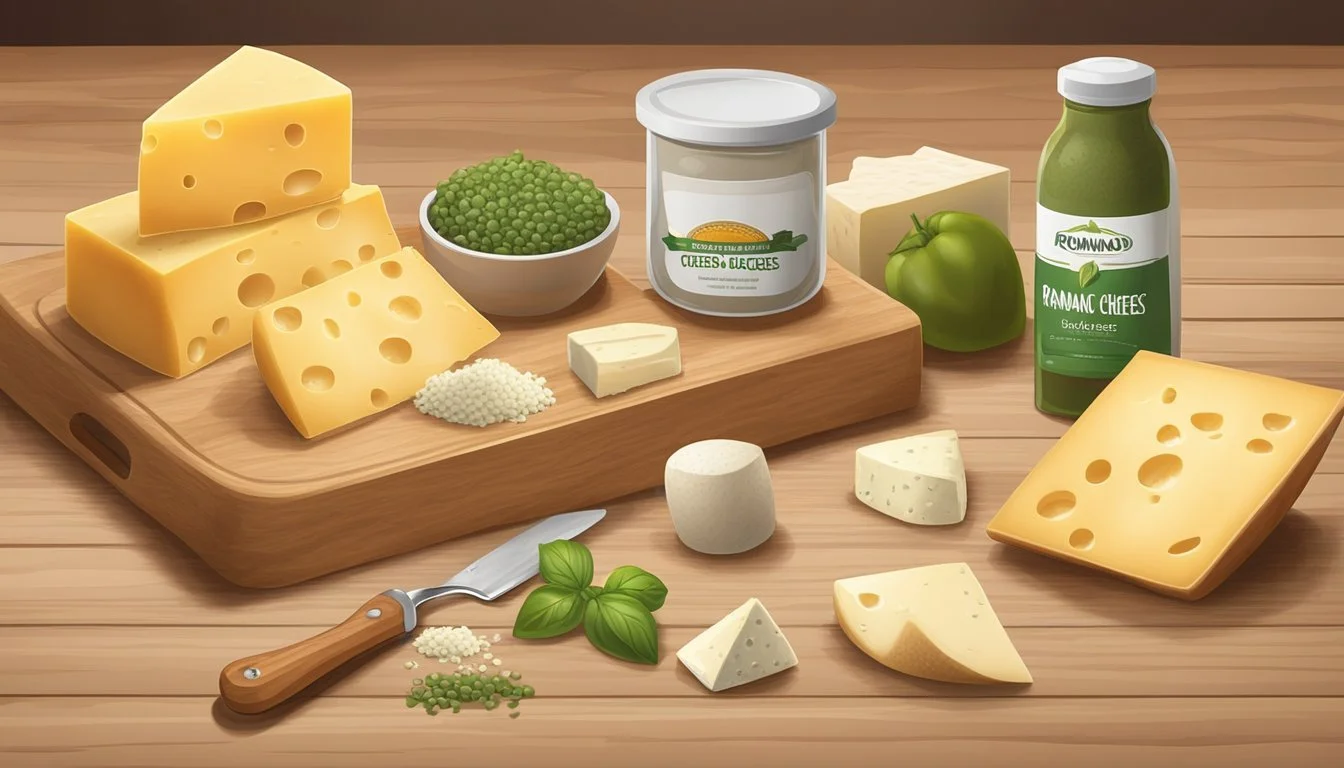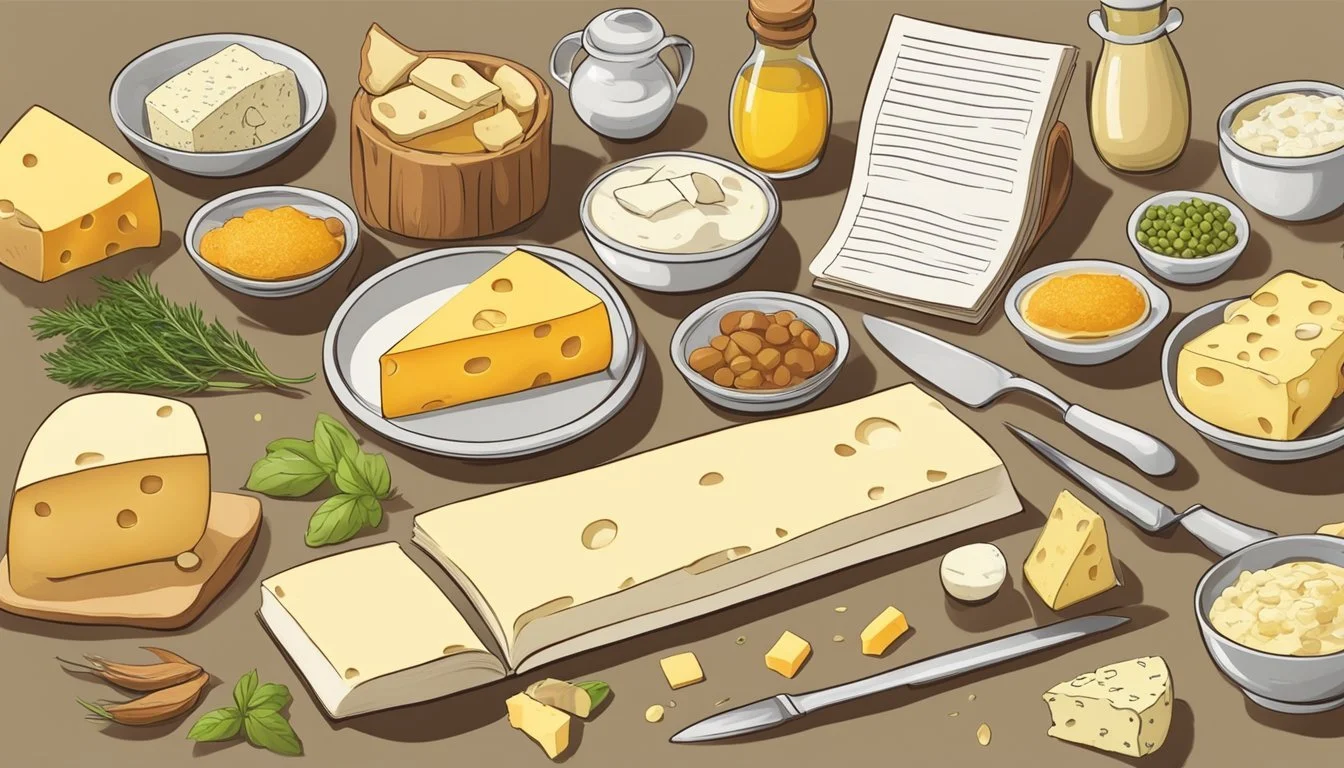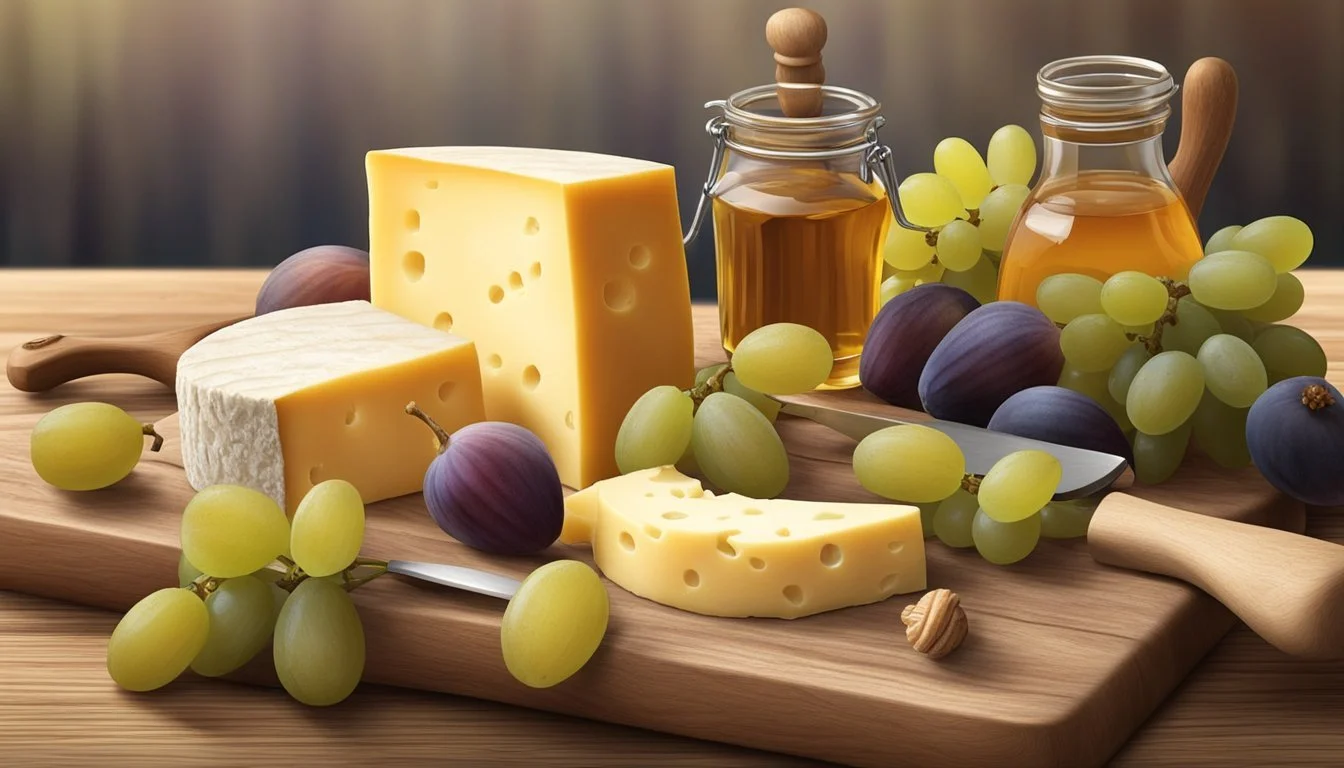Romano Cheese Alternatives
Top Pecorino Romano Substitutes for Cooking
Romano cheese (What wine goes well with cheese?), specifically the well-known Pecorino Romano, is an integral component in Italian cuisine, prized for its sharp, salty flavor and a hard texture that grates beautifully. Originating from Italy, Pecorino Romano is made from sheep's milk and is often used in pasta dishes (What wine goes well with pasta dishes?), soups, and grated over pizzas and salads. Its robust flavor profile is not easily mimicked, but various situations—be it dietary restrictions, availability, or cost—necessitate finding a suitable substitute.
While there's no perfect match for this distinct cheese, several alternatives offer similar qualities. Parmigiano-Reggiano, another Italian cheese, provides a nuttier taste and less saltiness but mimics the dry, crumbly texture of Pecorino Romano, making it a favored alternative. Other cheeses like Piave have different aging stages, which allow cooks to select an option with the preferred texture—often firmer and drier with age—and substitute it in recipes that traditionally call for Pecorino Romano.
Substitutes are not confined to Italian cheeses alone. Manchego from Spain, with its firm and slightly crumbly texture, offers an intense, zesty flavor that can bring a unique twist to dishes. Similarly, Greek kefalotyri, often made from sheep or goat milk, can replicate the crumbly texture and tangy flavor of Pecorino, with the added benefit of melting well in heated dishes. Thus, for those unable to source Pecorino Romano or seeking a different taste profile, these substitutes can effectively complement the flavors of various recipes calling for the iconic Italian cheese.
Understanding Romano and Pecorino Romano Cheese
This section delves into the essential aspects of Romano and Pecorino Romano cheese, from their origins to their distinctive flavors and culinary uses.
Origin and Production
Romano cheese originates from Italy, with Pecorino Romano being a well-known variety. Pecorino Romano specifically comes from the regions of Lazio and Sardinia, among others. It is crafted exclusively from sheep’s milk, which gives it a distinct taste and texture.
Italy: Traditional producer of Pecorino Romano
Lazio & Sardinia: Primary producing regions
Sheep’s Milk: Sole milk source for Pecorino Romano
Flavor Profile
Pecorino Romano cheese is renowned for its bold and salty flavor profile. The taste intensifies with aging, yielding a nutty flavor that is sharper than many other cheeses. This hard cheese embodies the characteristics of traditional Italian cheeses.
Bold & Salty: Prominent taste features
Nutty Flavor: Emerges with maturity
Aging: Enhances depth of flavor
Texture and Characteristics
Texture is an important characteristic of Pecorino Romano. It is firm to the touch and becomes more crumbly as it ages. These properties not only influence its taste but also its suitability for grating.
Firm: Consistent texture of a young Pecorino Romano
Crumbly: The texture as it ages, making it ideal for grating
Culinary Uses
Pecorino Romano is versatile in the kitchen and is often grated over pasta, soups, and salads. It is a key ingredient in Italian dishes like Bucatini all'Amatriciana and Cacio e Pepe, imparting a rich, umami flavor to these classic recipes.
Grating: Common preparation for Pecorino Romano
Italian Dishes: Essential for authentic flavor in traditional recipes
Why Substitute Pecorino Romano?
Pecorino Romano cheese is known for its distinctively sharp flavor and firm texture, making it a staple in many dishes. However, various circumstances such as dietary restrictions or availability may necessitate the exploration of suitable substitutes.
Dietary Restrictions
Vegan: Pecorino Romano is made from sheep's milk, which is not suitable for vegan diets. Vegans can opt for cheese alternatives made from plant-based ingredients such as nuts or soy.
Dairy-Free: Individuals with dairy intolerances or allergies need alternatives that replicate Pecorino's unique qualities without containing lactose or other dairy components. Dairy-free cheeses often use coconut oil, tapioca, and nutritional yeast to mimic the flavor and texture.
Flavor Preferences
For those who find Pecorino Romano too intense or salty, milder options are available that offer a different flavor profile while still providing a similar consistency when grated. Substitutes like Parmigiano-Reggiano are less salty and offer a nuttier taste, while still being versatile in a range of recipes.
Availability and Cost
Pecorino Romano can be expensive or hard to find in certain regions. Cheaper or more readily available cheeses such as Piave or even well-aged Manchego serve as economical substitutes without compromising on quality. The cost and accessibility can vary greatly depending on one's location and the cheese's country of origin.
Cheese Substitutes for Pecorino Romano
When searching for a Pecorino Romano cheese substitute, one may consider characteristics such as flavor, texture, and how well the cheese melts. Here are the top alternatives categorized by type.
Similar Italian Cheeses
Parmesan (Parmigiano-Reggiano): This cheese is well-known for its nutty flavor and grainy texture. It is an ideal substitute due to its similar aging process, albeit being less salty than Pecorino Romano.
Aging: 18-36 months
Texture: Hard and crumbly
Flavor Profile: Nutty, less salty
Asiago: For a milder flavor, Asiago can replace Pecorino Romano in many recipes. A younger Asiago will be creamier and less pungent.
Aging: Variable; fresh to over a year for Asiago d'Allevo
Texture: Semi-soft to hard depending on age
Flavor Profile: Mild and creamy when young; develops pungency with age
Grana Padano: It's slightly less salty than Pecorino but offers a similar granular texture, making it a good alternative for grating over dishes.
Aging: Minimum 9 months
Texture: Hard, grainy
Flavor Profile: Savory, less intense
Non-Italian Cheese Alternatives
Spanish Manchego: Ideal for a distinctive flavor twist, aged Manchego has a firm texture that can grate well on dishes requiring Pecorino Romano.
Origin: Spain
Texture: Firm to hard
Flavor Profile: Intense, zesty
Ricotta Salata: This salted version of Ricotta cheese is more solid and can be grated or crumbled. It offers a milder flavor but works well in salads and pastas.
Texture: Firm, slightly crumbly
Flavor Profile: Mild, slightly salty
Vegan and Dairy-Free Substitutes
For those avoiding dairy, nutritional yeast and cashews are popular plant-based alternatives due to their capacity to impart a cheesy flavor.
Nutritional Yeast: This seasoning has a cheesy, nutty flavor and can be sprinkled over dishes to mimic Pecorino Romano’s taste.
Flavor Profile: Cheesy, nutty
Usage: Sprinkle as a flavor enhancer
Cashews: When soaked and blended, cashews can form a creamy base that mimics the texture and taste of cheese. Adding acidity like lemon juice or vinegar and nutritional yeast contributes to a closer flavor resemblance.
Texture: Creamy when blended
Flavor Profile: Can be adjusted with additives to taste cheesy
Choosing the Best Substitute
When seeking an alternative to Pecorino Romano, the key considerations are to match its distinct taste and texture. A suitable substitute should impart a similar salty sharpness and umami while retaining the consistency desired in the dish.
Taste and Flavor Matching
Pecorino Romano is known for its salty sharpness and rich umami quality. For a comparable flavor profile, Parmigiano-Reggiano rises as the top option, renowned for its nuttiness and less pronounced saltiness. Grana Padano, although slightly sweeter, also offers the umami and sharpness necessary for many recipes.
Textural Considerations
The texture of a cheese plays a significant role in how it performs in a dish. Piave cheese exhibits a range of textures from semi-hard to firm, depending on its age, becoming crumblier as it matures. It can mirror Pecorino's firm and crumbly nature when well-aged. Manchego cheese, especially when aged as Manchego Viejo, provides a firm, slightly crumbly texture suitable for grating.
Substitute Versatility
A flexible substitute is key for various culinary applications. Kefalotyri, a staple in Greek cuisine, has a bold taste and a crumbly yet meltable quality, making it versatile for both savory baked dishes and grated applications. Its rich flavor is on par with Pecorino's distinctive sharpness and buttery notes, ensuring it can hold its own in a range of recipes.
Incorporating Substitutes in Recipes
When using substitutes for Pecorino Romano in recipes, chefs must consider how the alternate cheese will interact with the other ingredients, focusing on balance in terms of saltiness and the umami characteristics that Pecorino adds to a dish.
Pasta Dishes
For traditional pasta dishes such as Carbonara or Cacio e Pepe, the substitute cheese should mimic Pecorino's characteristic sharpness and salt content.
Parmigiano-Reggiano: With its rich, nutty flavor, it’s less salty and can be used in grating over Spaghetti or mixing into the sauce.
Piave: Aged Piave brings a sweet note, allowing it to work well in these pasta dishes when used conservatively due to its slightly creamier texture.
Salads and Soups
Pecorino adds a punch of flavor to Salads and Soups; substitutes should meld well with the dressing or broth without overwhelming other flavors.
Grana Padano: Milder than Pecorino, it can gently complement salad greens or enhance the taste profile of soups.
Asiago: A younger Asiago offers a semi-sweet taste suitable for salads, while aged Asiago can be ideal for adding depth to soups.
Sauces and Baking
In creating sauces or for use in baking, where Pecorino's melting characteristics and savory taste are important, substitutes must provide similar meltability and flavor notes.
Piave: In sauces, its texture adapts well to heat, creating a smooth consistency akin to melted Pecorino.
Aged Cheddar: When baking, an aged cheddar could provide both the strong flavor and the desired texture, making it a versatile addition to many recipes.
Nutritional Comparison
When considering Pecorino Romano cheese and its substitutes, one must assess their nutritional profiles. Pecorino Romano is known for its high content of protein and calcium.
An average serving of Pecorino Romano (1 ounce) contains roughly:
Protein: 8 grams
Fat: 7 grams
Calcium: 330 mg
The cheese is also a good source of phosphorus and contains trace amounts of zinc and vitamins, albeit in lesser quantities compared to its macronutrient content.
In contrast, Parmesan (Parmigiano-Reggiano), a common substitute, offers slightly different nutritional benefits. An equal serving of Parmesan provides:
Protein: 10 grams
Fat: 7 grams
Calcium: 336 mg
Parmesan carries a higher protein content while maintaining similar fat levels and marginally higher calcium compared to Pecorino. Both cheeses impart significant nutritional value with their dense profiles of essential nutrients.
Another substitute, Piave, varies in nutritional content based on aging. As the cheese ages, moisture content decreases and nutrients become more concentrated. Aged Piave, similarly to Parmesan, would have increased levels of protein and minerals like calcium.
It is essential to remember that while substitutes can mimic flavor profiles, their nutritional compositions can differ, which might be a consideration for dietary balance. Consumers should review the nutritional labels of these cheeses to understand the impact on their own nutritional needs and requirements.
Pairings and Serving Suggestions
When considering substitutes for Pecorino Romano cheese, one must take into account the appropriate pairings and serving suggestions to best complement the flavors. This includes selecting the right wine, food combinations, and serving temperatures to ensure a harmonious dining experience.
Wine Pairings
Red Wine: For a robust flavor experience, a bold red wine pairs well with the intensity of Pecorino Romano substitutes. Options include:
Italian Cheeses: Choose a Chianti or a Barolo for their full-bodied nature which complements the sharp and salty notes of cheeses such as Parmigiano-Reggiano or aged Manchego.
Food Combinations
Fruity and Nutty: Combinations that feature fruits or nuts can balance the saltiness of the cheese, such as:
Fruits: Pears or figs add a sweet counterpoint.
Nuts: Walnuts or almonds offer a satisfying crunch and earthiness.
Olive Oil: A drizzle of high-quality extra virgin olive oil over the cheese enhances the flavors and adds a layer of richness.
Serving Temperatures
To maximize the flavor and texture of Pecorino Romano substitutes, serving them at the right temperature is essential:
Parmigiano-Reggiano: Serve at room temperature to let the nutty and less salty flavors fully develop.
Aged Manchego: Allow it to sit out for 20 to 30 minutes before serving to accentuate its zestiness.
By adhering to these pairing and serving guidelines, the character and taste profiles of Pecorino Romano cheese substitutes can be beautifully showcased, elevating any culinary preparation they are a part of.
Exploring Cheeses from Italy and Beyond
When considering alternatives to Pecorino Romano, it is worth looking into Italy's rich cheese heritage along with select international options. The unique characteristics, origins, and textural profiles of these cheeses contribute to their suitability as substitutes.
Parmigiano-Reggiano and Its Unique Character
Parmigiano-Reggiano is renowned for its granular texture and complex flavor profile. Originating from regions such as Parma, Modena, and parts of Bologna, this cheese is aged longer than Pecorino Romano, typically between 12 to 36 months. Affectionately known as the "king of Italian cheeses," its less salty yet nuttier taste makes it an excellent alternative for those seeking a substitute with pedigree and versatility.
Parmigiano-Reggiano Characteristics Texture Granular, crumbly Flavor Profile Nutty, Less Salty Aging Duration 12-36 months
Other Sheep's Milk Cheeses
Cheeses made from sheep's milk, like Pecorino Toscano, represent another dimension of Italian cheesemaking. Produced in Tuscany, specifically within provinces like Grosseto, Pecorino Toscano's flavor is milder and sweeter when young but develops a robust intensity with age. The term "pecorino" simply refers to "ovine" or "of sheep," with many regional variations existing throughout Italy.
Sheep's Milk Cheese Alternatives Pecorino Toscano Tuscany, Grosseto Flavor Evolution Mild to Robust with Age
Regional Variations of Italian Cheeses
Italy offers a vast spectrum of cheeses with distinct regional identity. Asiago Cheese, produced in areas like Trentino and Veneto, is notable for its range of flavors depending on aging, from "Asiago Pressato" (mild and smooth) to "Asiago d'Allevo" (Vecchio and Stravecchio for older varieties). Each region's cheese reflects its unique terroir, providing an array of alternatives to Pecorino Romano with diverse textures and tastes.
Regional Italian Cheeses Asiago (Pressato) Trentino, Veneto Asiago d'Allevo (Vecchio) Trentino, Veneto Texture Ranges from smooth to crumbly Flavor Varies from mild to sharp
How to Store and Preserve Cheese
Proper Storage is essential for maintaining the quality and extending the shelf life of cheese, including varieties like Pecorino Romano. To preserve cheese effectively, one should wrap it in parchment paper, wax paper, or butcher paper. This method allows the cheese to breathe and stay dry, preventing the growth of mold.
For best results, place the wrapped cheese in the refrigerator's cheese drawer or vegetable crisper. These compartments are designed to maintain a stable humidity level, which is crucial for cheese preservation.
Shelf Life
Pecorino Romano cheese, when stored correctly, can last for 2-3 weeks in the fridge before it starts turning dry and hard.
Aging cheese requires specific conditions, often with controlled humidity and temperature suitable for the type of cheese.
Health Benefits
Properly storing cheese not only retains its flavor but also its Health Benefits. Cheese is a good source of protein and calcium, and maintaining its quality through appropriate storage means these benefits can be fully utilized by the body.
If the intention is to store cheese for a longer duration, one might consider sealing it in a vacuum-pack or wrapping it in paper and then in aluminum foil to provide an extra barrier against moisture and odors from other foods. However, one should regularly check for any signs of spoilage and consume the cheese within the recommended time frames for safety and quality reasons.
Guide to Buying Cheese
When seeking a substitute for Pecorino Romano, it's essential to look for quality and authenticity in the options available. This section will guide readers through finding quality cheese, understanding cheese labels, and identifying the best places to purchase quality cheese.
Finding Quality Cheese
One should examine the cheese for unique characteristics such as color, texture, and aroma, which can be indicative of its quality. Sardo, for example, is a variety similar to Pecorino Romano that can be found in high-quality iterations with a firm texture and a sharp, salty flavor. Authenticity plays a role as well; cheeses with a Denominazione di Origine Protetta (DOP) label guarantee that they are produced in a specific region under strict regulations, ensuring traditional methods and high standards.
Understanding Cheese Labels
Cheese labels carry valuable information, with terms like DOP being crucial. This label ensures that the cheese is produced within a specific geographic zone using recognized know-how, such as Pecorino Romano DOP from Lazio or the La Mancha region's famous Manchego cheese. These cheeses possess unique characteristics bestowed by their terroir, and these designations help consumers to identify them.
Where to Purchase Quality Cheese
Quality cheese can typically be found in specialty cheese shops or high-end supermarkets with a dedicated cheese counter. For authentic Pecorino Romano or its substitutes, one might consider stores that source cheeses directly from the producers or regions noted for their quality, like those with DOP certifications. Additionally, online retailers specializing in gourmet foods are potential sources, offering a broad selection from various regions, including La Mancha and other notable cheese-producing areas.
The Cultural Significance of Cheese
In Italy, cheese is not merely a food product but an integral part of the country's heritage and culinary tradition. Across the diverse regions, one can find a variety of cheeses integral to local culture and cuisine. Pecorino Romano, specifically, is a testament to this tradition—a hard, salty cheese originating from the Italian region of Sardinia.
Italian cheeses such as Pecorino Romano are often used in various culinary creations, becoming synonymous with the flavors of Italy. The significance of these cheeses extends beyond taste; they are a part of the country's history, with cheesemaking techniques passed down through generations, reflecting regional terroirs and ancient customs.
In comparison, the La Mancha region of Spain is known for its Manchego cheese, which, similar to Italy's Pecorino Romano, holds a cultural prestige and is deeply rooted in local traditions. Manchego, however, is made from the milk of Manchega sheep and displays unique characteristics pertinent to La Mancha.
Country Region Cheese Milk Source Italy Sardinia Pecorino Romano Sheep Spain La Mancha Manchego Manchega Sheep
The cross-cultural comparison highlights the role of cheese as a cultural identifier, with protected designations and controlled production methods ensuring the legacy and authenticity of these treasured foods. Regardless of their origin, cheeses such as Pecorino Romano are savored for their ability to convey a sense of place, tradition, and communal identity.



